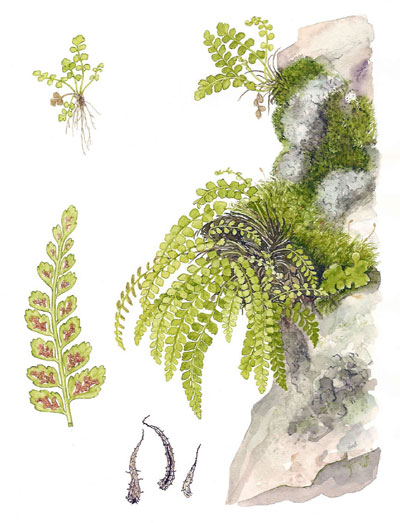|
Hardy Fern Home A. viride resources
All Ferns � Aspleniaceae �� Asplenium
�Other Genera
|
| Asplenium viride | ||
Green spleenwort | ||
|
Etymology
Viride means green.
Description
Rhizome: erect, short, branching, scales clathrate, dark brown to black, to 4 mm.
Frond: 18 cm high by 1.2 cm wide, evergreen, somewhat dimorphic, fertile fronds stiff, erect, sterile prostrate, only to 10 cm, blade/stipe ratio: 1:1 to 6:1. Stipe: reddish brown at base, green distally, lustrous, dark reddish brown to black, narrowly triangular scales grading into glandular hairs, vascular bundles: 2 C-shaped, back to back, uniting to 1 upwards in an X-shape. Blade: 1-pinnate, linear, widest above the middle, tapering to either end, thin, pale green, glabrous or with sparse minute hairs. Pinnae: 6 to 21 pair, rhombic or ovate, apex rounded to acute, sometimes toothed, subopposite; costae indistinct; margins crenate or entire; veins free, forked. Sori: linear, 1.5 mm, 1-2 pairs per pinna, paired across the midrib, indusium: white or translucent, thin, entire, often deciduous, on one side of the sorus, sporangia: brown, maturity: midsummer to late fall. Dimensionality: pinnae tilted forward in lower part of blade. Culture
Habitat: limestone crevices.
Distribution: circumpolar, but extending far south to Mexico, North Africa, Formosa.
Hardy to -40�C, USDA Zone 2.
Distinctive Characteristics
The green rachis sets it aside from the other 1-pinnate spleenworts.
Synonyms
Asplenium trichomanes-ramosum Linnaeus |
|
|
Notes
Nomenclature A. trichomanes-ramosum is the valid name by the rules, by FNA, but has lost the race for acceptance on Google, and with at least one pteridologist, C.N. Page, because of causing needless confusion with A. trichomanes.
Nomenclature A. trichomanes-ramosum is the valid name by the rules, by FNA, but has lost the race for acceptance on Google, and with at least one pteridologist, C.N. Page, because of causing needless confusion with A. trichomanes.

Asplenium viride. a) fronds; b) fertile pinnae. �Illustration by V. Fulford from Ferns and Fern Allies of Canada, William J. Cody and Donald M. Britton, 1989, � Agriculture Canada, used with permission. |
